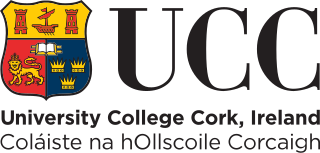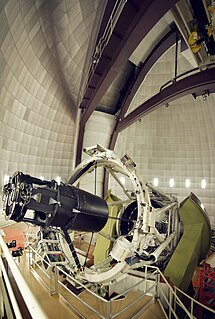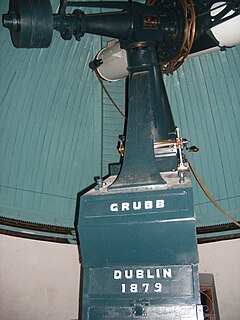
The Royal Observatory, Greenwich is an observatory situated on a hill in Greenwich Park in east London, overlooking the River Thames to the north. It played a major role in the history of astronomy and navigation, and because the Prime Meridian passes through it, it gave its name to Greenwich Mean Time, the precursor to today's Coordinated Universal Time (UTC). The ROG has the IAU observatory code of 000, the first in the list. ROG, the National Maritime Museum, the Queen's House and Cutty Sark are collectively designated Royal Museums Greenwich.

An observatory is a location used for observing terrestrial, marine, or celestial events. Astronomy, climatology/meteorology, geophysical, oceanography and volcanology are examples of disciplines for which observatories have been constructed. Historically, observatories were as simple as containing an astronomical sextant or Stonehenge.

The Paris Observatory, a research institution of the Paris Sciences et Lettres University, is the foremost astronomical observatory of France, and one of the largest astronomical centers in the world. Its historic building is on the Left Bank of the Seine in central Paris, but most of the staff work on a satellite campus in Meudon, a suburb southwest of Paris.

Cork Institute of Technology (CIT) was a third level educational institution in Ireland, located in Cork. Upon its dissolution, the institute had 17,000 students in art, business, engineering, music, drama and science disciplines. The institute had been named as Institute of Technology of the Year in The Sunday Times University Guide for Ireland on numerous occasions. On 1 January 2021, CIT merged with IT Tralee to become Munster Technological University, Ireland's second Technological University.
Sir James South FRS FRSE PRAS FLS LLD was a British astronomer.

University College Cork – National University of Ireland, Cork (UCC) is a constituent university of the National University of Ireland, and located in Cork.

The Anglo-Australian Telescope (AAT) is a 3.9-metre equatorially mounted telescope operated by the Australian Astronomical Observatory and situated at the Siding Spring Observatory, Australia at an altitude of a little over 1,100 m. In 2009, the telescope was ranked as the fifth highest-impact of the world's optical telescopes. In 2001–2003, it was considered the most scientifically productive 4-metre-class optical telescope in the world based on scientific publications using data from the telescope.

Armagh Observatory is an astronomical research institute in Armagh, Northern Ireland. Around 25 astronomers are based at the observatory, studying stellar astrophysics, the Sun, Solar System astronomy and Earth's climate.

Markree Observatory was an astronomical observatory in County Sligo, Ireland. The asteroid 9 Metis was discovered from this observatory in 1848 by Cooper's assistant Andrew Graham using a comet seeker telescope. The observatory was also home to the largest refractor of the early 1830s, which had a 13.3-inch (340 mm) aperture Cauchoix of Paris lens; the largest in the world at that time. The observatory also housed a number of instruments and was operated to varying degrees throughout the 19th century.

Goldendale Observatory State Park is an educational facility on the northern side of Goldendale, Washington, notable for its unusually large public telescope. The state park occupies five acres (2.0 ha) atop a 2,100-foot (640 m) hill.

The Dunsink Observatory is an astronomical observatory established in 1785 in the townland of Dunsink near the city of Dublin, Ireland.

Sir Howard Grubb, Parsons and Co. Ltd. was a telescope manufacturer, more commonly known as Grubb Parsons. It was based in Newcastle upon Tyne, in England.

The University of Illinois Astronomical Observatory, located at 901 S. Mathews Avenue in Urbana, Illinois, on the campus of the University of Illinois Urbana-Champaign, was built in 1896, and was designed by Charles A. Gunn. It has been listed on the National Register of Historic Places since November 6, 1986, and on December 20, 1989, was designated a National Historic Landmark.

Cork is the second largest city in Ireland, located in the south-west of Ireland, in the province of Munster. Following an extension to the city's boundary in 2019, its population is c. 210,000.

Fuertes Observatory is an astronomical observatory located on the North Campus of Cornell University in Ithaca, New York. The observatory was designed by L.P. Burnham, Cornell Professor of Architecture and completed in fall of 1917. It was originally used by the Civil Engineering Department as an instructional field office for navigation and surveying. Today, the observatory is primarily used for public outreach, welcoming over two thousand visitors per year with open houses on clear Friday nights.

Blackrock Castle is a castellated fortification located at Blackrock, about 2 km from Cork city centre on the banks of the River Lee in Ireland. Originally developed as a coastal defence fortification in the 16th century to protect upper Cork Harbour and port, the site now houses an observatory, visitor centre and restaurant.

The Quito Astronomical Observatory is a research institute of EPN, the National Polytechnic School in Quito, Ecuador. Its major research fields are astronomy and atmospheric physics.

Three College Observatory (TCO) is an astronomical observatory owned and operated by The University of North Carolina at Greensboro (UNCG), North Carolina Agricultural and Technical State University, and Guilford College (GC). Built in 1979, it is located 10 kilometers (6 mi) south of Graham, North Carolina (USA), in the Cane Creek Mountains. The observatory, designed by W. Edward Jenkins, was funded with a $250,000 grant, however, it would cost $1.5 million to replace it today. The observatory's primary instrument is a 32 in (81 cm) Ritchey-Chrétien reflecting telescope attached to an equatorial mount. It was built by Sigma Research and installed at TCO in 1981. TCO is used by UNCG for instruction and outreach. It continues to be the largest telescope in North Carolina and ones of the largest telescopes in the southeast.

Potsdam Great Refractor is an historic astronomical telescope in an observatory in Potsdam, Germany.




















